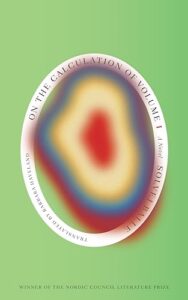
Apparently, the Danish Groundhog Day-style litfic series On the Calculation of Volume has gotten enough hype for English translations. And while I can be hit-or-miss on litfic, I enjoy weird time shenanigans and meditative stories enough to check out the fairly short first installment in the planned seven-part series, translated by Barbara J. Haveland.
On the Calculation of Volume is told via a series of diary entries by a French secondhand bookseller who is trapped living the same day over and over again. When the story starts, she’s been living it for months, quietly camping out in the guest room to avoid having to explain the situation to her husband for what feels like the thousandth time. But the bulk of the story consists in her recollections of the early days of the loop—her repeated examinations of the first day in (fruitless) hope of finding a trigger, her early experiments with her husband, and her slow descent into isolation and despair—before later shifting into shorter entries sticking more closely to the current iterations of the loop, meditating on her impact on the world and attempts to break out of the pattern.
To veteran genre readers, much of the setup will be familiar. The lead mysteriously finds herself in a time loop, triggering attempts to understand why it started, how it works, and how she can free herself. And despite being much more meditative than plotty, On the Calculation of Volume doesn’t shirk any of these aspects. But this particular use of the diary format does insert some distance between the reader and the events, as each development is mediated through the author’s recollection. One result, for instance, is that there is no dialogue at all, only the lead’s paraphrase of remembered conversations. I could see this hitting different readers quite differently, but I found the style engaging. It’s certainly not a book that’s easy to read quickly, but at just over 150 pages, it’s not like a slower pace will leave a reader stuck for weeks.
The narrative also has a nice balance of action and meditation. The action may not be violent—the lead establishes quickly that injuries persist through the loop and never seeks death as a way out—but attempts at both interpersonal connection and scientific experimentation make sense for the character and nicely punctuate the more existential segments in which she inevitably wonders what kind of monster she is or what purpose she has when she can make no positive effect on the world. Neither element really jumps out as so deeply compelling as to make the story unforgettable, but it remains a good read.
The biggest problem comes in the series format. While this book is short and unintimidating, and while this book is pleasant to read, the knowledge that there are six more to come reminds the reader not to expect too much progress, prompting questions about why it exists as a separate volume. As a veteran epic fantasy reader, I’m fully accustomed to the sort of opening book that resolves one plot thread while setting the stage for a much bigger series-long arc. But On the Calculation of Volume resolves little, feeling less like the opening book in a series and more like the opening chapters to a giant novel. And while a 150-page novel may have been unintimidating, a 1,000-page novel with similar pacing sounds like it has real slog potential.
There’s not much wrong with On the Calculation of Volume except for the inevitable question about its role in the series. It doesn’t really do enough to be worth reading by those who don’t plan to press on, but neither does it provide enough to whet the appetite for an extended series. It’s a pleasant read for fans of meditative time loop stories, but it feels less like a short novel and more like a small piece of a giant one. And while I enjoyed my time with it, it doesn’t have me excited for six more.
Recommended if you like: litfic-style Groundhog Day stories.
Can I use it for Bingo? It’s hard mode for First in a Series. It’s also Published in 2024.
Overall rating: 13 of Tar Vol’s 20. Three stars on Goodreads.
